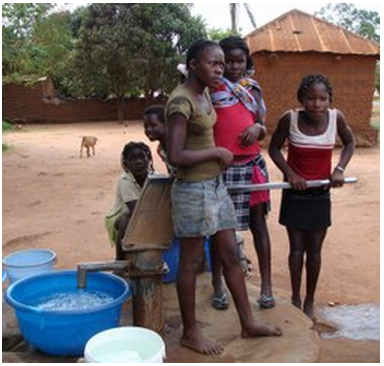India Mark 2 and 3

Contents
India Mark ll pump
The India Mark II Pump is a robust conventional lever action handpump. It is designed for heavy-duty use, serving communities of 300 persons. The maximum recommended lift is 50 m. The India Mark II is a public domain pump defined by Indian Standards and RWSN specifications. The India Mark II pump is not corrosion resistant. It requires special skills for installation as well as for the maintenance, therefore it is not considered to be a VLOM pump. The pump body parts are Hot-Dip Galvanized and as such are extremely durable over the years.
The India Mark 2 Pump is also available in the following versions:
- Force & Lift India Mark 2
- With a choice of stands like Telescopic, 3 legged, Square pedestal, Vergnet type stand, etc.
- Extra Deepwell India Mark 2
- Ghana Modified India Mark 2.
For places where the water is very corrosive, the following components are available:
- Stainless Steel Connecting Rods
- Stainless Steel Riser Pipes
- Stainless Steel Cylinder Assembly with all Stainless Steel cylinder components
- PVC Riser Pipes
Construction, operations and maintenance

India Mark ll
The Mark II is a closed-cylinder pump. The cylinder brass-lined cast iron with the foot valve and piston assemblies made of brass. The piston seals are double nitrile rubber cup seals. The top and bottom of the piston cylinder are “capped” with threaded reducers. The diameter of the pump cylinder is larger than the diameter of the riser main to which it is attached.
Maintenance on any part of the pump cylinder requires that the riser main and the pump rod be removed from the ground.The pump rod is galvanized steel and sections are threaded together. The pump cylinder is threaded onto the last section of riser main and is removed in its entirety as the last component to come out of the ground. The pump cylinder can then be unscrewed from the riser main. The top and bottom caps can be unscrewed from the cylinder body to gain access to the foot valve, the piston valve, the piston seals and anything else inside the cylinder body.
Manuals, videos, and links
- Do it yourself India Mark ll maintenance: IDRC India Mark II Manual. International Development Research Centre (IDRC).
Acknowledgements
- India Mark II Pump. RWSN.
- India Mark ll Handpump. S.K. Industries
- Water Hand Pumps Like the India Mark II Have Been Around For Years and Are Used Worldwide. CleanWaterforLaymen.com
